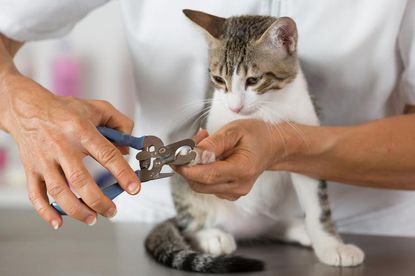
Imagine going to a salon and asking to have your nails trimmed, and they take out a large pair of clippers and cut your nail off at the knuckle. This is the horrifying truth about declawing your cat.
 As described by Cats International, “the term ‘declawing’ makes people think only the claw is removed, but a more appropriate description would be amputation/mutilation.
As described by Cats International, “the term ‘declawing’ makes people think only the claw is removed, but a more appropriate description would be amputation/mutilation.
Declawing fits the dictionary definition of mutilation to a tee. Words such as deform, disfigure, disjoint, and dismember all apply to this surgery. It doesn’t matter how the procedure is preformed, scapula, guillotine or laser. The end result is the same “EXCORIATING PAIN.” This is the barbaric reality of declawing your cat.

“Sensory and motor nerves in the cat’s paw are cut, damaged, and destroyed. Recovery from the surgery is a slow and a painful process. The pain from declawing is life-long and normal cat behaviors are forever gone. This procedure keeps our cats from enjoying pain free things such as walking, running, springing, climbing, and stretching. This crippling procedure keeps our cats from a life of fun energetic normal cat behavior.”
Soft Paws — Soft Paws are an excellent alternative to declawing. They are easy to apply at home, and cats and their owners love them. They are completely safe and humane and can be used on cats of all ages. Soft Paws are vinyl nail caps that are glued on to your cat’s existing nails. They look like a cat’s nail, only hollow. They are easy to apply and cats tolerate them extremely well. I have personally used this product and can say, without a doubt, they are very effective… and pretty!!!
So what are the alternatives to this horrible act of mutilation? There are four options to choose from, which are known to be successful.
Feliway — Have you seen cats rubbing their cheeks on an object? Because cats are territorial, they are compelled to mark their territory. When they are rubbing their faces on things, they are doing just that. Scratching is another way cats mark their territory. Not only does scratching provide a visual marking of the territory (the shredded material) but also, cats have scent glands on the bottom of their paw pads, which deposit a scent discernible only by other cats. Think of it as their “feel good” pheromone. Feliway is a synthetic version of your cat’s facial pheromone. Spraying Feliway on objects you do not want your cat to scratch effectively deposits this feel good pheromone so your cat doesn’t feel the need to scratch the object.
Double-Sided Tape — Products such as Pioneer Pet Sticky Paws on a Roll Cat Deterrent is sticky on both sides. Simply apply it to the objects you would prefer your cat not scratch on, and his natural aversion to stickiness will put an end to the offending behavior. The tape works as an aversion tool, but you still need to provide a place for kitty to scratch — such as a scratching post.
Cat Scratching Posts — Cats will always scratch, it is in their nature. The key is to provide your cat with a post that he/she prefers over your furniture.
Height. The post needs to be tall enough for your cat to stretch and extend in order to get a full and satisfying scratch. The picture to the right shows a good example of a cat getting a “full and satisfying” stretch.
The post must be stable. If it wobbles, your cat won’t like it, and if it topples over your cat won’t want to get near it again.
The best material for cat scratching posts is sisal fabric. Not sisal rope, but sisal fabric. This woven material provides great texture for shredding — which cats love to do when scratching, and it feels good on their paws. When a cat scratches the sisal material, he can drag his claws down this satisfying material over and over in a continuous motion. In contrast, sisal rope creates an interrupted scratch — scratch, bump, scratch, bump, scratch, bump. Not very satisfying.
There are 28 countries in which declawing cats is either illegal or considered extremely inhumane and only performed under extreme circumstances.
In July of 2019, New York became the first state in America to make declawing illegal.
Although the Humane Society of the Nature Coast has accepted the surrender of cats that have been subjected to this barbaric practice, we will refuse to allow ANYONE to adopt a cat from our shelter who plans on having it declawed.

So… Imagine going to a salon and asking to have your nails trimmed, and they take out a large pair of clippers and cut your nail off at the knuckle. This is the horrifying truth about declawing your cat.


i think instead of cutting off the joints declawing should be where you trim the nails of the cat that’s just me
Because the nail will continue to grow unless the source is cut off. Unfortunately that means taking away the whole knuckle
i would never cut my cat knuckle of i would just cut there nails
My cats have been declawed as tiny kittens. They run and jump and play as normal just 3 or 4 days after claws removed.
Prevents future trauma from pinning them down to trim nails.
Plus they never get in trouble for scratching on wrong items
What part of declawing is evil do you not understand?? There is a reason why MANY countries and now some states in the US have banned it. Think about it. Be a better human.
Jesse, you should never be allowed to own another cat. If you think cutting a cat’s fingertips (including the BONE) does not have lifetime effects, you are not at the mental maturity to own a cat.
I own two cats, and from the time they were kittens I have clipped their nails every two week. It has never bothered them and certainly never traumatized them.
My cats have definitely scratched things they weren’t supposed to, especially when they were little, which is why I invested time and money into giving them a variety of scratching posts and other scratching equipment. Since then they haven’t scratched anything they weren’t supposed to. I would NEVER punish a cat for doing so, as it is their nature and it’s cruel to do so.
I hope you never own another cat!!!
This breaks my heart it’s so sad to do this I mean if you have to do that to have a cat then my god find another animal or something because this is just so wrong it’s abuse and absolutely no cats should ever go through this 😔😞😭
While I believe that there are better alternatives to decline than the methods they use right now I think that many of the statements they make about decline cats are grossly exaggerated. The agonizing recovery. Turns out to be about 3 days and you just got to watch them so that they don’t try and jump up or off of things and then they’re much better off however I would like to see some method used where they kill the nail bed and the claws just fall off and don’t grow back I don’t understand why they can’t do that and if they did the cat could keep its knuckle and all the sensory organs and such in the feet.
There is NEVER a good reason to torture a cat
As a vet tech, I can tell you the recovery is at least a week with bandages, then the mental and more physical recovery. If they somehow slip out of the house they can’t climb a tree or anything else to get away from predators.
There have been multiple studies on declawing and no, the effects are not exaggerated.
You would want something to permanently kill the claw and it never grow back…? You realize that does permanent damage to the bone and tendon right?
If you can’t handle trimming your cat’s nails twice a month and providing plenty of scratching areas for them, you should not own a cat. Period.